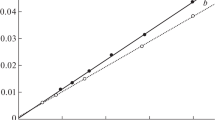Summary
The rapid growth and extensive utilization of chromatography as an analytical method has necessitated improvement of the associated data reduction process. More prompt final data and increased accuracy demand automated techniques. The development of modern solid-state electronics has enabled computer-aided solutions to chromatographic data reduction problems. Increasing software costs and decreasing hardware production costs couple to give new solutions — small calculator-like systems and large distributed computer systems. Currently available U. S. system types will be surveyed and future trends will be conjectured.
Zusammenfassung
Das schnelle Anwachsen und der weitgehende Einsatz der Chromatographie als analytisches Verfahren hat eine Verbesserung der damit zusammenhängenden Datenverarbeitung erforderlich gemacht. Schnellere Endresultate und erhöhte Richtigkeit verlangen nach automatisierten Verfahren. Die Entwicklung der modernen Festkörper-Elektronik hat Lösungen mit Computer-Unterstützung für die Probleme der chromatographischen Datenverarbeitung ermöglicht. Steigende Kosten für Software und sinkende Produktionskosten für Hardware wirken bei der Entstehung neuer Lösungen zusammen — kleine rechnerähnliche Systeme und große verteilte Computer-Systeme. Die derzeit in den USA verfügbaren Systeme werden begutachtet und zukünftige Trends abgeschätzt.
Résumé
La croissance rapide et l;utilisation deplus en plus large de la chromatographie a rendu nécessaire l' amélioration des méthodes de dépouillement des données. Pour obtanir les résultats définitifs plus rapidement et avec une plus grande précision il est indispensable de recourir à des méthodes automatisées. Le développement de la miniaturisation en électronique (transistors, circuits imprimés) a permis de résoudre avec l'aide du calculateur les problèmes posés par le dépouillement des données chromatographiques. L'accroissement du coût du software et simultanément, l'abaissement des coûts de production des calculateurs, conduisent à, de nouvelles solutions: installation de dispositifs locaux analogues à de petits calculateurs et système de gros calculateurs éloignés utilisés «en temps partagé». On expose les différents système disponibles de façon courante aux Etats-Unis, et l'évolution probable de la situation.
Similar content being viewed by others
References
James, A. T. andMartin, A. J. P., Biochem. J.,50, 679 (1972).
Klopfenstein, C. K., J. Chrom. Sci.,10, in press (1972).
Schomburg, G. andZiegler, E., J. Chrom. Sci.,9, in press (1971).
Sederholm, C. H., Paper presented at 1971 Pittsburgh Confenrence.
Prater, C. D., Kaufman, W. andWilliams, B., Proc. Conf. on Computers in Chemistry, Northern Illinois Univ., DeKalb, Ill., July 19–23, 1971.
Zaks, R., Steingart, D. andMoore, J., Proc. Spring Joint Comp. Conf.,38, May 18–20, 1971, AFIPS Press.
Blackney, W. J., Jr., Proc. IBM Scientific Computing Symposium on Computers in Chemistry, White Plains, New York (1969).
Gill, J., J. Chrom. Sci.,10, in press (1972).
Author information
Authors and Affiliations
Additional information
This work was performed under the auspices of the U. S. Atomic Energy Commission.
Rights and permissions
About this article
Cite this article
Anderson, R.E. Trends in chromatographic automation. Chromatographia 5, 105–107 (1972). https://doi.org/10.1007/BF02268302
Received:
Issue Date:
DOI: https://doi.org/10.1007/BF02268302




